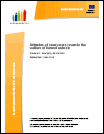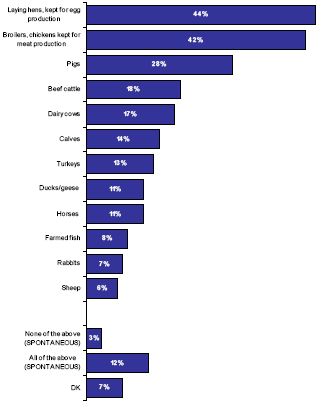



Attitudes of consumers towards the welfare of farmed animals
By the European Commission - This survey focus's particularly on the attitude of consumers to the welfare and protection of farmed animals. The survey has been carried out by TNS Opinion & Social, interviewing 24 708 citizens in the 25 Member States of the European Union between 9 February and 20 March 2005.Table of contents
Introduction
 The welfare of farmed animals
The welfare of farmed animals
- Knowledge of farms where animals are reared
- Opinion on the protection of farm animals
- Laying hens
- Dairy cows
- Pigs
- Species to be protected as a priority
- Thinking about animal welfare when purchasing
- Identification of rearing systems
- Buying
- Impact of purchasing behaviour on animal welfare
- Are consumers prepared to pay more for a better welfare for laying hens?
- Perceptions of existing legislation
- The transport of farmed animals
- The slaughter of farmed animals
- The conditions under which animals are kept on farms
- Comparative perceptions of animal welfare
- The welfare and protection of farmed animals in the European Union
Technical specifications
Questionnaire
Tables
Introduction
European Union policy for food safety aims, among other things, at ensuring a high
level of food quality, animal health as well as animal welfare and protection.
The Amsterdam Treaty, which came into force in May 1999, establishes new
fundamental rules for the European Union's animal protection measures in the
"Protocol on protection and welfare of animals". It officially recognises that animals are
sentient beings and requires the European Institutions and Member States to give full
regard to the welfare requirements of animals in formulating and implementing
Community legislation.
The new Treaty establishing a Constitution for the European Union, signed on 29
October 2004 by the heads of States and Governments of the 25 Member States as
well as the three candidate countries, also undertakes to ensure the protection of
animals.
That is the background against which this survey, focusing more particularly on the
attitude of consumers to the welfare and protection of farmed animals, was
commissioned by the European Commissionfs Health and Consumer Protection
Directorate General. The survey has been carried out by TNS Opinion & Social,
interviewing 24 708 citizens in the 25 Member States of the European Union between 9
February and 20 March 2005. The methodology used is that of Eurobarometer surveys
as carried out by the Directorate General for Press and Communication (Unit for
Opinion Polls, Press Reviews, Europe Direct). A technical note on the manner in which
interviews were conducted by the Institutes within the TNS Opinion & Social network is
in the annex of this report. This note indicates the interview methods and the
confidence intervals.
This report tackles the following themes in turn:
- the welfare of farmed animals,
- purchasing behaviour and the welfare of farmed animals,
- and animal welfare at the European level.
Furthermore, we have systematically cross-analysed the responses to all the questions with additional classification variables, i.e.:
question 1, on the frequency with which respondents purchase food for the household,
question 2, regarding the frequency of meat consumption,
question 3, on the frequency with which meat is purchased with animal welfare in mind.
question 4, on the frequency of visits of animal rearing farms,
question 5, concerning farm animals for which the welfare should be most improved,
question 6, regarding the identification on the label of the animal welfare friendly production systems,
question 7, concerning the impact of buying animal welfare friendly products on the protection/ welfare of farm animals,
question 8, more specifically, on the rating of the welfare of laying hens, dairy cows and pigs,
question 9, the source of eggs,
question 10, concerning the price premium the respondent would be willing to pay for eggs sourced from an animal welfare friendly production system.
1.2.1. Laying hens: A negative view of the welfare of laying hens in a majority of Member States
The analysis of results by country highlights the differences in opinion across the
European Union. In a clear majority of Member States, most respondents gave a
negative opinion about the welfare of laying hens.
The Dutch and the Danish (77%), followed by the Germans and Belgians (73%), are
the most critical in this respect. In these same countries, a significant proportion of
respondents, close to or over 30%, also have a very negative opinion of the welfare of
laying hens.
However, 68% of Maltese had a positive view of the welfare and protection of these
animals.
Finally, the non-response rates (people who answered “don’t know” or who did not
answer the question) varied appreciably from one Member State to another. It
exceeded 20% in the Baltic States.
Q8.1 In general, how would you rate the welfare/protection of the following farmed animals?

1.3. Species to be protected as a priority Source: question 5
After measuring the perceptions of respondents regarding the welfare of certain species, this third point aims to identify the farmed animals for which respondents thought that welfare and protection should be most improved.
The level of welfare of laying hens and broiler chickens to be improved as a priority
More than four in ten citizens of the European Union mention laying hens and chickens
kept for meat production among the three species most needing improvements in
terms of welfare and protection. Concerning the laying hens, this result is a logical
consequence of the very critical perception that Europeans have regarding the welfare
of this animal.
Pigs are mentioned in third place and dairy cows in fifth place by respectively 28% and
17% of respondents. These results seem, therefore, to confirm those analysed at point
1.2., i.e. the perceived better rearing conditions of these last two species.
On the whole, we can also note that 58% of the respondents cited three species while
12% mentioned two species and 8% cited one. It is also noteworthy that 12% of
respondents stated that the welfare of all the species mentioned needed to be
improved.
Q5 In your opinion, from the following list, for which three farm animals should the current level of welfare/protection be improved the most? (MAX. 3 ANSWERS)

The other species seem to concern respondents very little. Nevertheless, some
exceptions exist: 28% of Slovenians and 26 % of Germans cited turkeys; 38% of
Belgians mentioned ducks; 36% of Greeks stated farmed fish while 29% cited sheep;
44% of Poles mentioned horses (for more details please see table in the annex).
We could imagine that these results are linked to country-specific factors, the lower
consumption rates for these animals or their products, to their corresponding degree of
rearing systems or to a lesser knowledge of these rearing systems.
The analysis by country (see graphs on next page) for the three species whose
welfare and protection European Union citizens consider should be improved as a
priority highlights significant differences in the rates at which this was mentioned in
the different Member States.
a. Hens reared kept for egg production
The Scandinavians (between 58 and 73%), Dutch (66%), Germans (65%) and Belgians (62%), are particularly vociferous in calling for improvements in the rearing conditions of hens reared for egg production. More that 55% of them mentioned these animals among the three species for which they most wanted welfare improvements. Lithuanians (20%), Spaniards (23%) and Estonians (26%), on the other hand, seldom mentioned this species.
b. Chickens kept for meat production
Around three citizens in four in Sweden (75%), Denmark (74%) and Greece (70%) mention chickens raised for meat production among the three species for which they hope to see improvements in welfare and protection as a priority. By contrast, chickens raised for meat production are particularly seldomly mentioned in the Baltic States (between 13 and 24%).
Further Information
To continue reading this report, please click here (138 page PDF)
Source: European Commission - June 2005








